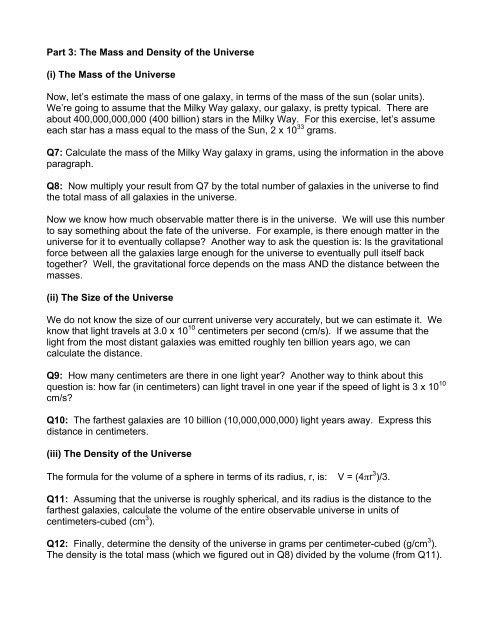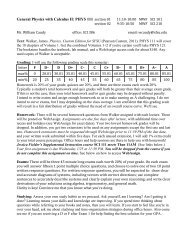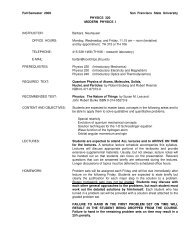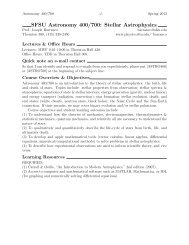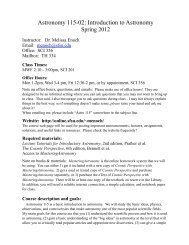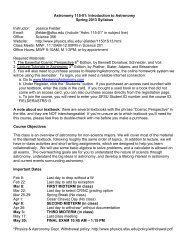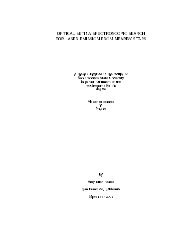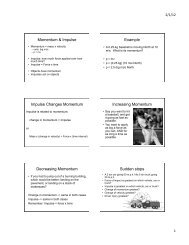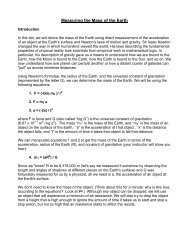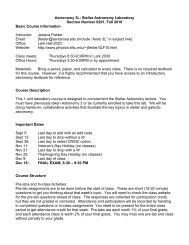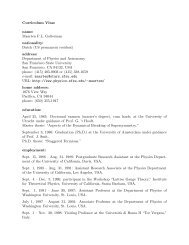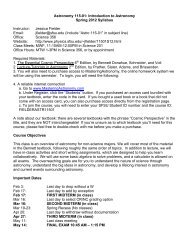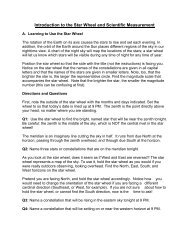Lab for Jul. 14 (The Hubble Deep Field) - SFSU Physics & Astronomy
Lab for Jul. 14 (The Hubble Deep Field) - SFSU Physics & Astronomy
Lab for Jul. 14 (The Hubble Deep Field) - SFSU Physics & Astronomy
Create successful ePaper yourself
Turn your PDF publications into a flip-book with our unique Google optimized e-Paper software.
Part 3: <strong>The</strong> Mass and Density of the Universe<br />
(i) <strong>The</strong> Mass of the Universe<br />
Now, let’s estimate the mass of one galaxy, in terms of the mass of the sun (solar units).<br />
We’re going to assume that the Milky Way galaxy, our galaxy, is pretty typical. <strong>The</strong>re are<br />
about 400,000,000,000 (400 billion) stars in the Milky Way. For this exercise, let’s assume<br />
each star has a mass equal to the mass of the Sun, 2 x 10 33 grams.<br />
Q7: Calculate the mass of the Milky Way galaxy in grams, using the in<strong>for</strong>mation in the above<br />
paragraph.<br />
Q8: Now multiply your result from Q7 by the total number of galaxies in the universe to find<br />
the total mass of all galaxies in the universe.<br />
Now we know how much observable matter there is in the universe. We will use this number<br />
to say something about the fate of the universe. For example, is there enough matter in the<br />
universe <strong>for</strong> it to eventually collapse? Another way to ask the question is: Is the gravitational<br />
<strong>for</strong>ce between all the galaxies large enough <strong>for</strong> the universe to eventually pull itself back<br />
together? Well, the gravitational <strong>for</strong>ce depends on the mass AND the distance between the<br />
masses.<br />
(ii) <strong>The</strong> Size of the Universe<br />
We do not know the size of our current universe very accurately, but we can estimate it. We<br />
know that light travels at 3.0 x 10 10 centimeters per second (cm/s). If we assume that the<br />
light from the most distant galaxies was emitted roughly ten billion years ago, we can<br />
calculate the distance.<br />
Q9: How many centimeters are there in one light year? Another way to think about this<br />
question is: how far (in centimeters) can light travel in one year if the speed of light is 3 x 10 10<br />
cm/s?<br />
Q10: <strong>The</strong> farthest galaxies are 10 billion (10,000,000,000) light years away. Express this<br />
distance in centimeters.<br />
(iii) <strong>The</strong> Density of the Universe<br />
<strong>The</strong> <strong>for</strong>mula <strong>for</strong> the volume of a sphere in terms of its radius, r, is: V = (4πr 3 )/3.<br />
Q11: Assuming that the universe is roughly spherical, and its radius is the distance to the<br />
farthest galaxies, calculate the volume of the entire observable universe in units of<br />
centimeters-cubed (cm 3 ).<br />
Q12: Finally, determine the density of the universe in grams per centimeter-cubed (g/cm 3 ).<br />
<strong>The</strong> density is the total mass (which we figured out in Q8) divided by the volume (from Q11).


